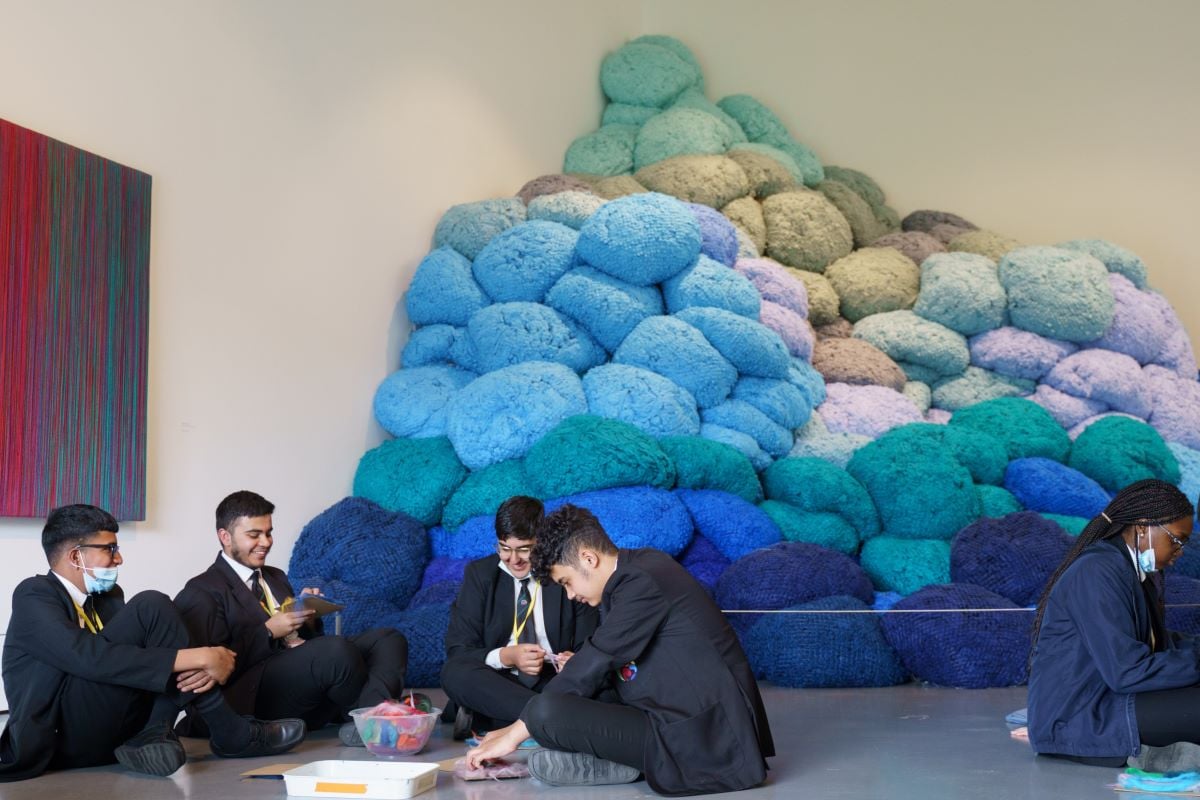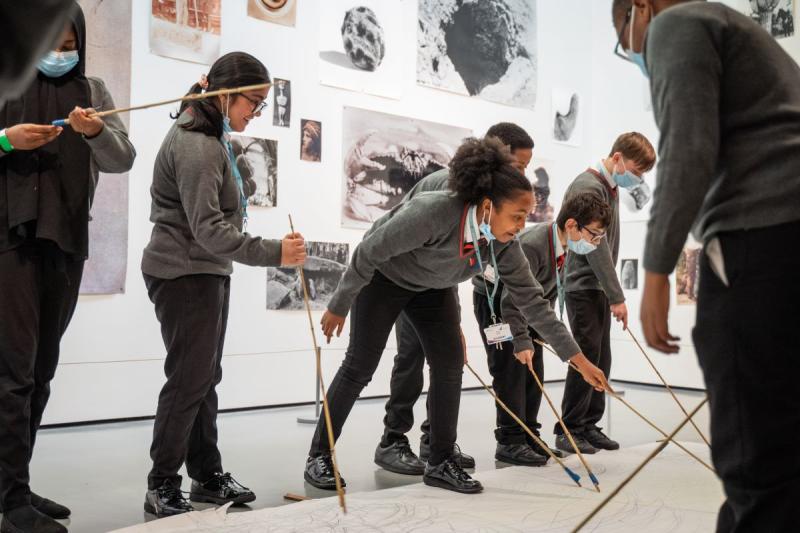
Carlton Keighley students at The Hepworth Wakefield
Photo: Michael Godsall
The arts in schools: Foundations for the future
The 1982 publication ‘The Arts of Schools’ was hugely influential with local education authorities and arts professionals. Here Sally Bacon and Pauline Tambling share the findings from their new consultation, more than 40 years later.
The 1982 report prompted wide debate about the importance of arts teaching and learning at a time of huge change in the education system, with the introduction of the National Curriculum (1988) and the beginnings of what became academisation. For our new report we talked to more than 300 educators, arts professionals and policy makers, as well as consulting young people aged 18-26.
Our final full report, The Arts in Schools: Foundations for the Future, sets out detailed findings, but the top-level finding is that access to the arts in schools can no longer be assumed in either the primary or secondary system. And while professional arts organisations have developed impressive learning and participation programmes, these cannot compensate for a lack of arts in the curriculum or access to specialist arts teaching in schools.
Arts-confident headteachers and multi-academy trusts can still offer a sound arts education, but the odds are stacked against them as they battle with a focus on examination grades, inspection and accountability measures which do not value the arts.
Lack of value ascribed to the arts
We can distil our findings into three central conclusions, starting with what we know about the value of the arts in young people’s lives. Since 1982 we have built much more evidence about the ways in which arts subjects and experiences contribute to improving outcomes for children and young people, providing them with foundational skills for life and skills for work.
In addition to providing memorable experiences, we know that the arts can provide a creative outlet which enables children to explore and express their emotions, and their identities, and which can support their wellbeing. We describe the arts as being ‘full spectrum’ subjects in developing attributes ranging from critical thinking, to collaboration, to creative freedom. A rich arts education supports the development of many desirable skills and capacities valued by young people and by employers, including teamwork, empathy, problem-solving, self-confidence, imagination, and innovation.
But despite all that we now know about their value for children and young people, there is a lack of value ascribed to the arts within the state education system in England. Since the introduction of the National Curriculum there have been multiple changes of direction and little focus on the overall purposes of education.
There is no systemic rationale for what is taught, and no coherent and ambitious vision for education in relation to the economy, society, community or the individual. As a result, we have a schooling system that prioritises school performance based on exam grades in defined subject areas, and in which success measures do not value the whole child. In the absence of consensus around purpose, in the context of increased accountability focused on a narrow range of subject areas, and acute funding pressures, there has been a systematic downgrading or exclusion of arts subjects and experiences.
 The Ruth Gorse Academy students at The Hepworth Wakefield. Photo:Michael Godsall
The Ruth Gorse Academy students at The Hepworth Wakefield. Photo:Michael Godsall
Downgrading of arts is damaging
At every stage in the schooling system the arts are disadvantaged, starting with the lack of arts specialists at primary level. The prioritisation of EBacc (non-arts) subjects in secondary accountability measures has led to a reduction in the level of arts subject teachers and resources available, and therefore declining GCSE and A Level take-up.
Dance and drama have no parity at school or inspection level, and film and digital media have been excluded from the national curriculum. We have an assessment regime that does not work for arts subjects, which require different kinds of measurement, and the investment required to develop these has not been made because of their perceived low status.
This downgrading of the arts is damaging for young lives and aspirations, for the arts education workforce, for the workforce more widely, and for the health and diversity of the creative industries. And access to the arts is not equitable: we have a two-tier system, with the arts highly valued and well-resourced in independent schools.
Finally, many of the problems we identify are as much about the wider context in which learning takes place as about the specific challenges for the arts in schools. As in 1982, we have been writing at a time of social and political change, when the country is facing significant challenges, and when all political parties believe that investment in education and skills will be key to economic growth.
We have arrived at a knowledge-centred approach to learning, and a system that has the objective of creating the employees of the future has failed to embrace what employers say they want – or the value of the arts on a personal level to young people – and has prioritised learning to count over learning to create. The system is still running on outdated policies without a clear purpose for what schools are equipping young people with, or why.
Call for a new public conversation about education
Whenever there has been disquiet about the place of the arts in schools, the response has been to offer non-statutory guidance, or to put in place time-limited ‘pilot’ and ‘targeted’ projects or plans to fill the gap. We see the existence of these interventions as evidence that the arts have not had a central place in schooling, and that arts subjects have been consistently sidelined.
Our report does not make a special case for the arts but calls for a new public conversation about education in England, as has happened in Scotland and Wales, where the Expressive Arts have a distinct and equal curriculum status. We believe we need to look at what happens in schools anew, examining its fitness for the current context, and to involve educators, parents, young people and employers, and the professional arts sector in the conversation. We need a broader, more balanced curriculum for our schools, one that equips young people for the present as well as the future.
One of our ten recommendations is arts-sector specific. Public funding for the arts is under pressure so we would like to see more collaboration between education and arts policy makers and funders to maximise the resources of the professional arts sector and ensure their relevance to schools (including, importantly, online), and responsive to their needs. If schools are to access programmes, projects and resources from the professional arts sector, it is important that there is support and active brokerage work in order for them to do so.
Equally important is continued support and proper resourcing for arts sector schemes that validate and encourage best practice in school and youth arts provision, such as Artsmark and Arts Award, and the arts being part of education for employment to build a trained workforce for a thriving and diverse creative industries sector.
Four decades on from the original report there are now widespread calls for education system change: our report shows that change is necessary and possible. In the past, major shifts in education policy – such as in 1944 – have emerged from times of crisis. We conclude by asking if right now might be just such a time?
Pauline Tambling CBE and Sally Bacon OBE have worked for many years in national roles in the arts and cultural sector as funders, practitioners, policy and programme makers, and trustees, with a special interest in education.
![]() www.anewdirection.org.uk/the-arts-in-schools
www.anewdirection.org.uk/the-arts-in-schools
![]() @paulinetambling | @CGF_UK
@paulinetambling | @CGF_UK
![]() sally-bacon-obe | pauline-tambling-cbe
sally-bacon-obe | pauline-tambling-cbe
See www.anewdirection.org.uk/the-arts-in-schools to access the full Calouste Gulbenkian Foundation publication, The Arts in Schools: Foundations for the Future report; an Executive Summary; an accompanying 40-year timeline; and a series of case studies providing practical examples of what works well in schools. Published by A New Direction in partnership with the former Bridge organisation network.
Join the Discussion
You must be logged in to post a comment.